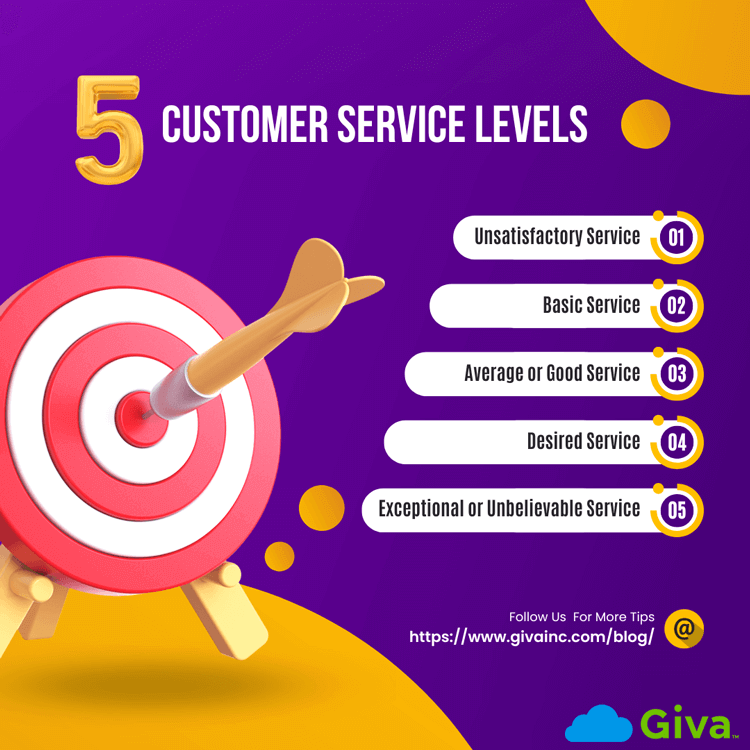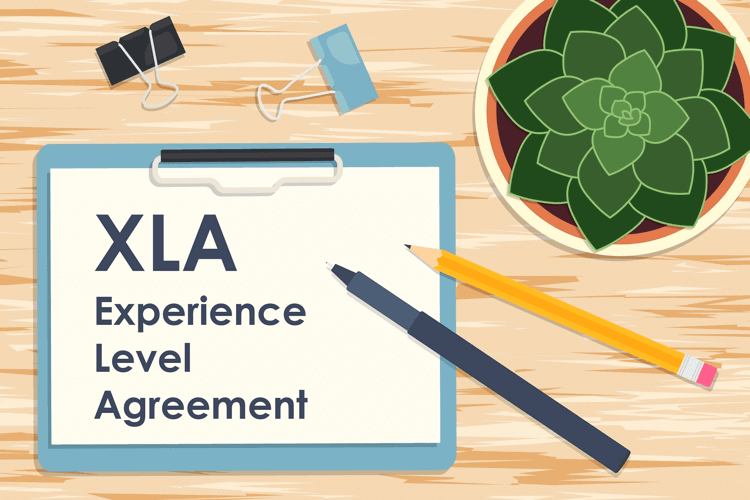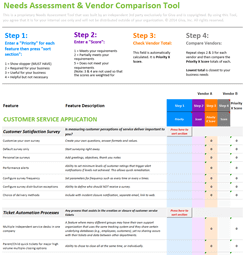Customer Service Levels: Definitions, Importance and 20 Creative Improvement Strategies
Determining the current customer service level of any support organization plays an indispensable part of a company's success and reputation. Advancing a team's service level helps ensure lasting customer satisfaction and loyalty.

In this article, we define the standard customer service levels, why it is important to understand them, and then offer strategies to help advance any team to the next level and beyond.
What is a Customer Service Level?
A customer service level defines the standards and quality of service that a company provides to its customers. The various levels determine how well a company meets or exceeds customer expectations. This in turn can significantly impact customer satisfaction, loyalty, and overall business success.
High service levels can lead to:
- Positive word-of-mouth
- Repeat business
- A strong reputation
Contrariwise, poor service levels can result in:
- Customer complaints
- Negative reviews
- Loss of business
The Different Customer Service Levels Defined
The following lists the 5 generally-recognized levels of customer service:
-
Level 1: Unsatisfactory Service
This level is marked by:
- Frequent mistakes
- Long wait times
- Unhelpful responses
- A general lack of concern for customer needs
Why This is Important
- Customers often leave dissatisfied and may not return
- Can lead to negative reviews and a damaged reputation
-
Level 2: Basic Service
At this level:
- Service is functional but minimal
- Companies meet the basic customers' needs without going beyond what is necessary
- Transactions are completed, but there is little effort to make the experience positive
Why This is Important
- While customers' basic needs are met, there is little loyalty or satisfaction
- Customers are likely to switch to competitors if given the choice
-
Level 3: Average or Good Service
Here:
- Service is reliable and consistent
- Customers receive the help they need in a timely and efficient manner
- Employees are trained and capable
Why This is Important
- Most interactions meet customer expectations
- Customers are generally satisfied and moderately loyal
- It prevents negative feedback
- Helps maintain a steady customer base
-
Level 4: Desired Service
This level involves going beyond basic expectations:
- Customers feel valued and appreciated
- Service is proactive, and employees anticipate customer needs
- Personalized interactions are common
Why This is Important
- Customers are not only satisfied but also loyal
- They are likely to recommend the business to others
- Positive reviews and word-of-mouth marketing are common
-
Level 5: Exceptional or Unbelievable Service
Service at this level is extraordinary and memorable:
- Employees make significant efforts to ensure that customers have an exceptional experience
- Innovative solutions are standard
- A high level of personalization is produced
Why This is Important
- Creates brand advocates
- Delighted customers often share their positive experiences widely
- Leads to strong brand loyalty and a outstanding reputation
20 Creative Customer Service Level Improvement Strategies
The following are some great strategies to advance customer service excellence at any level:
-
Level 1: Unsatisfactory Customer Service
-
Service Recovery Programs
Implement a service recovery strategy that not only addresses issues but offers compensation like discounts or "freebies".
-
Surprise Audits
Conduct surprise audits and mystery shopper programs often to identify and fix service gaps quickly.
-
Customer Empathy Training
Hold workshops focused on empathy to help support staff understand and address customer frustrations more effectively.
-
Immediate Resolution Authority
Empower frontline employees with the authority to make on-the-spot decisions to resolve issues, reducing wait times.
-
-
Level 2: Basic Customer Service
-
Interactive FAQs
Develop website interactive FAQ sections using multimedia elements like videos and infographics to make information more accessible.
-
Community Support Forums
Create customer support forums where users can help each other and share solutions.
-
Interactive Tutorials
Offer interactive tutorials and walkthroughs for common issues, providing customers with step-by-step guidance.
-
Multi-Language Support
Provide support in multiple languages to cater to a diverse customer base.
-
-
Level 3: Average or Good Customer Service
-
Customer Journey Mapping
Use customer journey maps to identify pain points and enhance the overall service experience.
-
Feedback Loop
Establish a closed-loop feedback system where customers see the direct impact of their feedback through regular updates.
-
AI-Enhanced Support
Integrate AI tools that can analyze customer interactions and suggest improvements to service agents in real-time.
-
Personalized Follow-Ups
Send personalized follow-up messages after interactions to ensure issues are resolved and gather feedback for improvement.
-
-
Level 4: Desired Customer Service
-
Proactive Outreach
Implement systems that alert service teams to reach out to customers before they encounter issues.
-
Customer Health Score
Develop a customer health score to proactively address at-risk customers and improve their experience.
-
Loyalty Programs
Implement loyalty programs that reward customers for their continued business and positive interactions.
-
Customer Education Programs
Offer educational resources and webinars to help customers maximize the value of your products or services.
-
-
Level 5: Exceptional or Unbelievable Customer Service
-
Surprise and Delight
Regularly surprise customers with unexpected perks, such as handwritten notes, surprise gifts, or exclusive access to new products.
-
Customer Experience Labs
Set up dedicated labs to experiment with innovative service ideas and pilot them before full-scale implementation.
-
White-Glove Services
Provide premium services such as dedicated support lines, home visits, or personalized consultations for top-tier customers.
-
Customer Stories
Highlight and celebrate customer success stories through your marketing channels, making customers feel valued and appreciated.
-
Measuring and Monitoring Customer Service Level Success
Once service level strategies are implemented, it's important to measure how effective they are and fine tune them over time.
The following are important metrics and tools needed to measure customer service levels effectively and obtain actionable insights:
-
Key Performance Indicators (KPIs)
- Response Time: The average time taken to respond to customer inquiries. Faster response times generally lead to higher satisfaction.
- Resolution Time: The total time taken to resolve customer issues. Shorter resolution times indicate efficient problem-solving.
- Customer Satisfaction Scores (CSAT): Direct feedback from customers about their satisfaction with a specific interaction or overall service experience. These are typically collected through surveys.
- Net Promoter Score (NPS): Measures customer loyalty by asking customers how likely they are to recommend the company to others. High NPS indicates strong customer loyalty.
-
Feedback Mechanisms
- Surveys: Regularly conducted to gather customer opinions and satisfaction levels. These can be as an issue follow-up or at periodic times.
- Customer Interviews: In-depth discussions with customers to gain qualitative insights into their experiences and expectations.
- Social Media Monitoring: Tracking mentions and reviews on social media platforms to gauge customer sentiment and address issues promptly.
Tools and Technologies
- Customer Relationship Management (CRM) Systems: Centralize customer interactions and data. This can allow for better tracking and management of customer service metrics.
- Customer Service Software: Tools like issue tracking software that streamlines and automates customer service processes. These help provide timely responses and resolutions.
- Data Analytics: Analytics tracking of customer data to identify trends, patterns, and areas for improvement in service delivery.
Conclusion: Move Up the Customer Service Level Ladder for Business Success
More and more, customers expect increasingly exceptional customer service, making it essential for business success today. By understanding and improving customer service levels, businesses can ensure they not only meet but exceed customer expectations. This in return brings greater customer satisfaction and loyalty, and more positive word-of-mouth.
And finally, here are a couple of online courses that can help your team provide the best in customer care:
- Coursera: "Customer Service Fundamentals"
- LinkedIn Learning: "Customer Service Foundations" by Jeff Toister
Giva Can Help Streamline Your Customer Service Processes
Giva's intuitive design and easy setup allow your support organization to focus on the critical tasks of providing service to your customers.
Giva's features include:
- Severity Levels: Urgency ratings to keep focus on the top priorities
- Auto close rules and workflows
- Routing and action rules to convert emails into tickets including attachments and embedded images
- Custom ticket forms to capture additional necessary fields
- Customer Satisfaction Surveys: Capture feedback on a continuous basis to measure customer pulse
Book a free Giva demo today to see our solutions in action, or start your own free, 30-day trial!





